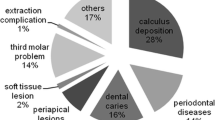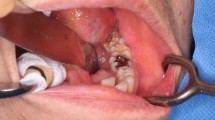Abstract
Osteonecrosis of the jaw has been linked with bisphosphonate use in breast cancer and multiple myeloma patients. We report 17 cases of patients with plasma cell dyscrasia being treated with bisphosphonate who developed osteonecrosis/osteomyelitis of the jaw.
Seventeen patients evaluated at our institution between 1998 and 2005 are reported. All were being treated with bisphosphonates for a median of 5 mo proor to the onset of jaw symptoms. Sixteen of the 17 patients are 54 yr or older. None of the patients had been irradiated in the jaw nor had obvious osseous manifestation of multiple myeloma in the jaw. Thirteen patients were receiving zoledronic acid and four patients were receiving pamidronate at the onset of jaw symptoms. Six of the 17 did receive both agents at some time and all of these individuals were receiving zoledronic acid at diagnosis. Microorganisms were isolated in 7/17 patients with the most common organism being actinomycosis.
We have initiated the following guidelines in an effort to ameliorate the incidence of this complication. Patients should have a full dental examination at the time of diagnosis of the plasma cell dyscrasia especially if bisphosphonates are to be considered as part of the therapy. In addition, bisphosphonates are held for a period of 3 mo prior to invasive dental procedures to allow for the osteoclastic recovery, therefore enhanced debris removal and lessening the chance of creating a fertile bacterial medium. Following the dental procedure we would re-introduce bisphosphonates only after the healing process is complete. Finally, multiple myeloma patients diagnosed with jaw osteonecrosis probably have a concurrent infection and should be aggressively treated with antibiotics.
Similar content being viewed by others
References
Phekoo KJ, et al. A population study to define the incidence and survival of multiple myeloma in a National Health Service Region in UK. Br J Haematol 2004: 127 (3):299–304.
Jemal A, et al. Cancer statistics, 2004. CA Cancer J Clin 2004:54 (1):8–29.
Berenson JR, et al. Efficacy of pamidronate in reducing skeletal events in patients with advanced multiple myeloma Myeloma Aredia Study Group. N Engl J Med 1996:334 (8): 488–493.
Berenson JR et al. Zoledronic acid reduces skeletal-related events in patients with osteolytic metastases. Cancer 2001;91 (7):1191–1200.
Rosen LS, et al. Zoledronic acid versus pamidronate in the treatment of skeletal metastases in patients with breast cancer or osteolytic lesions of multiple myeloma: a phase III, double-blind, comparative trial. Cancer J 2001;7(5): 377–387.
Rosen LS, et al. Long-term efficacy and safety of zoledronic acid compared with pamidronate disodium in the treatment of skeletal complications in patients with advanced multiple myeloma or breast carcinoma: a randomized, double-blind, multicenter, comparative trial. Cancer 2003:98(8):1735–1744.
Berenson JR, et al. American Society of Clinical Oncology clinical practice guidelines: the role of bisphosphonates in multiple myeloma. J Clin Oncol 2002: 20(17):3719–3736.
Marx RE. Pamidronate (Aredia) and zoledronate (Zometa) induced avascular necrosis of the jaws: a growing epidemic. J Oral Maxillofac Surg 2003;61(9):1115–1117.
Ruggiero SL, Mehrotra B, Rosenberg TJ, Engroff SL. Osteonecrosis of the jaws associated with the use of bisphosphonates: a review of 63 cases. J Oral Maxillofac Surg 2004;62(5):527–534.
Fleisch H. Bisphosphonates: mechanisms of action. Endocr Rev 1998;19(1):80–100.
Montangero VE, Capiglioni R, Roldan EJ. Mandible and maxilla bone mineral density and threshold analysis studies by pQCT in two edentulous women receiving pamidronate. Cranio 2003;21(2):110–115.
Santini D, et al. Pamidronate induces modifications of circulating angiogenetic factors in cancer patients. Clin Cancer Res 2002;8(5):1080–1084.
Kapitola J, Zak J. Effect of pamidronate on bone blood flow in oophorectomized rats. Physiol Res 1998;47(4):237–240.
Wood J, et al. Novel antiangiogenic effects of the bisphosphonate compound zoledronic acid. J Pharmacol Exp Ther 2002;302(3):1055–1061.
Little DG, Peat RA, McEvoy A, Williams PR, Smith EJ, Baldock PA. Zoledronic acid treatment results in retention of femoral head structure after traumatic osteonecrosis in young Wistar rats. J Bone Miner Res 2003;18(11):2016–2022.
Little DG, McDonald M, Sharpe IT, Peat R, Williams P, McEvoy T. Zoledronic acid improves femoral head sphericity in a rat model of perthes disease. J Orthop Res 2005; 23(4):862–868.
Agarwala S, Sule A, Pai BU, Joshi VR. Alendronate in the treatment of avascular necrosis of the hip. Kheumatology (Oxford) 2002;41(3):346–347.
Tenenbaum HC, Shelemay A, Girard B, Zohar R, Fritz PC. Bisphosphonates and periodontics: potential applications for regulation of bone mass in the periodontium and other therapeutic/diagnostic uses. J Periodontol 2002;73(7):813–822.
Adami S, et al. The acute-phase response after bisphosphonate administration. Calcif Tissue Int 1987;41(6):326–331.
Author information
Authors and Affiliations
Rights and permissions
About this article
Cite this article
Thakkar, S.G., Isada, C., Smith, J. et al. Jaw complications associated with bisphosphonate use in patients with plasma cell dyscrasias. Med Oncol 23, 51–56 (2006). https://doi.org/10.1385/MO:23:1:51
Received:
Accepted:
Issue Date:
DOI: https://doi.org/10.1385/MO:23:1:51




